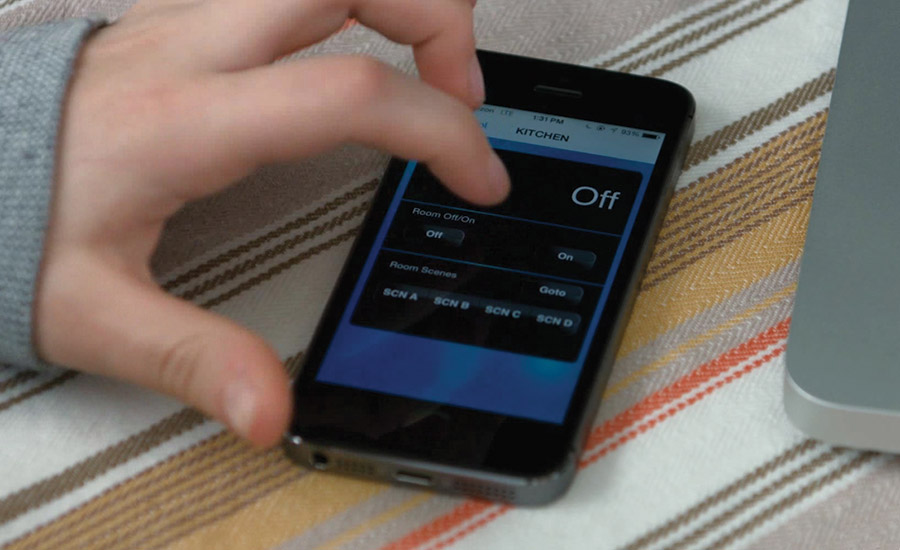Automated Lighting System Dos & Don'ts
Experts offer tips for success in a burgeoning business — from the initial sales call to installation and support.

Some lighting control systems, including those from Telguard, use the open IFTTT standard to enable consumers to create simple scenarios based on “if this, then that” logic.
PHOTO COURTESY OF TELGUARD

Some customers like the pizazz of being able to control their lighting from their smartphone, even when they are away from home.
PHOTO COURTESY OF LEVITON


New wireless technologies such as Zigbee and Z-Wave, combined with smartphone control, have brought pizazz to automated lighting control and made it affordable for almost any security account.
For dealers, this means extra revenue on alarm system sales and a means of enhancing customer loyalty. Some dealers may even generate extra recurring monthly revenue by providing ongoing support for lighting control systems.
Selling Lighting Control
Automated lighting control is typically sold at the time a customer buys an alarm system. So should dealers pitch lighting control on every job?
Not exactly, advises Scott Hoxler, president of Boynton Beach, Fla.-based security dealer Protection Plus. Hoxler notes that some people just aren’t interested in lighting control. He gauges customers’ level of interest in home control by how interested they are in using their smartphones to control their alarm systems. Those interested in smartphone control are more likely to buy video, lighting control, automated thermostats or some combination of those options, he says.
“If they just want security and they’re adamant about that, we leave it alone,” Hoxler comments.
Mark Komanecky, senior vice president of business development for Cambridge, Mass.-based equipment manufacturer BeON Home, advises security dealers to emphasize the safety aspects of automated lighting control. Customers generally are most impressed by capabilities such as the ability to turn on exterior lighting when approaching the home after a trip out, he argues.
Homeowners also tend to be impressed by the ability of lighting control to work in combination with the security system to deter offenders, comments Shawn Welsh, senior vice president of marketing for Telguard, a division of Atlanta-based Telular Corporation.
“If there is an intruder, the lights participate in deterring or getting them out of there just like the siren would,” Welsh says.
When it comes to lighting control, dealers may find that customers will start by controlling just a few lights but will add more lights at a later date.
“A common problem that a lot of people have is rolling up to the house in the pitch dark,” comments Greg Rhoades, director of marketing for Leviton Manufacturing Company of Melville, N.Y. “People can dip their toe in with outdoor lighting — the front and back porch lights.”
Rhoades advises dealers to follow up with customers six months after their initial lighting control purchase, as customers often will be willing to add additional lighting control at that time.
Rhoades also suggests that dealers consider creating alarm system packages that include lighting control. On average, security systems with lighting control are set up to control six lights, he notes. Accordingly, dealers may want to consider creating packages that includes control for six lights and a thermostat.
Managing Customer Expectations
Getting a lighting control installation right begins with the sales process.
Blake Deal, residential systems sales director for Coopersburg, Pa.-based manufacturer Lutron Electronics Company Inc., cautions salespeople not to pitch overly complicated systems. Just because a system can do certain things doesn’t mean salespeople should pitch every capability to every prospect, he says.
Salespeople should find out what people want to do with their systems — and installers should make sure people can do 85 percent of what they want to do, Welsh advises.
Welsh’s comment implies that salespeople should take care to manage expectations if that extra 15 percent just isn’t possible with today’s technology at the price the customer is willing to pay. Customers often will be satisfied if the dealer sets up just one or two lighting scenes, Welsh observes.
Managing customer expectations is particularly important for systems that use geofencing to turn lights on when the system detects that a customer returning home has come within a pre-specified range of the house. According to Hoxler, the technology works “most of the time but may not be 100 percent” — and dealers should caution customers in advance about this.
Welsh argues, though, that dealers often can overcome geofencing challenges by setting the geofence further from the home so that the system has more time to recognize that the end user has come within range. The system checks the end user’s location every few minutes, Welsh explains.
Installation Best Practices
How satisfied customers will be with their systems depends, in part, on the equipment that the dealer chooses for the installation. Jude Harper, registered communications designer for Tinton Falls, N.J.-based systems integrator Harper Technology Group, notes for example that some people may prefer the convenience of using a single smartphone app to control lighting, thermostats, and video; and that requirement dictates the use of certain manufacturers’ equipment.
In selecting equipment, dealers also should take care to choose lighting control systems that are as future-proof as possible, Rhoades says. For example, Rhoades advises dealers not to use products that can’t be used with LED lighting, as LED lighting is likely to become increasingly popular — and even customers who don’t use such lighting today may want to do so in the future.
With today’s lighting control systems relying so heavily on smartphone control, the quality of a customer’s digital cellular or landline Internet connection can impact system performance and customers’ satisfaction with the system, Hoxler comments.
Hoxler advises dealers to do a broadband speed test to help ensure the connection can support good system performance. If speeds are too slow, Protection Plus recommends that the customer change service providers to get better performance.
Installers should recognize the limitations of the Z-wave and Zigbee technology that is often used for communications between individual light controls and the alarm panel, Rhoades cautions. Z-wave covers a distance of about 30 feet, while Zigbee goes a bit further, he says.
Dealers also should recognize their own limitations. If a system requires light switches to be changed out, the dealer should enlist a licensed electrician to handle that task, Hoxler says. And because the quality of the job depends on the quality of the electrician’s work, the dealer should build a relationship with a reputable electrician who can be counted on to do the job right.
Dealers don’t want to find themselves in the position of having to fix pre-existing — and sometimes unrelated — electrical problems, says Rick Wlodyga, owner of Laguna Niguel, Calif.-based lighting and shade control dealer Technical Comfort Inc. As part of the initial quote process, Wlodyga says he walks through the home to see “what every switch does, what its current function is and how we can best implement” what the customer wants.
Some of today’s lighting control systems have unique capabilities that come with unique installation considerations.
For example, BeON Home offers a system that uses intelligent lightbulbs that are designed to begin flashing if they hear smoke alarms and burglar alarms. The system also can turn on certain interior lights when the doorbell rings — a useful capability considering that most intruders will ring the doorbell before breaking in, notes BeON Home CEO Alexei Erchak. To help ensure that the technology works correctly, Erchak cautions dealers against installing the bulbs in enclosed fixtures that could interfere with the device’s ability to detect alarms or doorbells.
Dealers that install lighting control should not overlook recurring monthly revenue opportunities. Even though today’s automated lighting controls are easy to use, some customers would rather leave maintenance to someone else and are willing to pay a monthly fee in order to do that, Rhoades adds.
Lighting control systems are a natural fit for today’s security systems, and selling and installing them can be a great opportunity for security dealers.
IFTTT Defined
Security dealers who get involved with automated lighting control will want to familiarize themselves with the acronym IFTTT for “If This, Then That.”
As Telguard Senior Vice President of Marketing Shawn Welsh explains, IFTTT is an open platform that enables lighting control systems to be tied in with other systems and to be set up so that if a certain event occurs or condition is detected, a certain action is automatically triggered. For example, a light might flash a certain color if the alarm system to which it is connected detects an intruder.
MORE ONLINE
For more on automated lighting control, visit SDM’s website where you’ll find the following articles:
“Lighting May Seem Simple, But Let’s Start with the Basics”
“Project Profile: Beyond Basic Lighting Control”
“The First Step to Full Building Automation is Lighting Control”
Looking for a reprint of this article?
From high-res PDFs to custom plaques, order your copy today!









